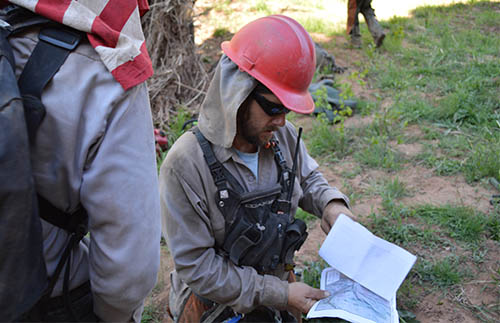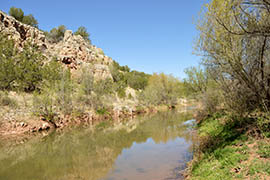Cronkite News has moved to a new home at cronkitenews.azpbs.org. Use this site to search archives from 2011 to May 2015. You can search the new site for current stories.
A thirsty invader endangers watersheds, native plants along Arizona waterways
PAULDEN – Sawdust flies as Tarl Norman lowers his chainsaw into the moist wood of a scrub tree growing along the Verde River. It topples into a growing pile of water-hungry tamarisks that Norman and the Lake Mead Exotic Plant Management Team are paid to remove here.
Another team member bends over to spray the oozing stumps with a red herbicide that will slowly starve what’s left of the invasive trees.
A mature tamarisk, also known as saltcedar, can consume 200-300 gallons of water a day and produce up to 250 million tiny seeds annually that are spread easily by the wind. So each removal in this corner of the Prescott National Forest is consequential.
“It’s a good feeling to know you’ve improving a watershed and helping species grow and thrive,” said Norman, who leads this team that specializes in removing tamarisks on federal land. “There’s not a whole heck of a lot of water in Arizona, so our priority has to be protecting that water.”
Arizona’s first settlers planted this African and Eurasian ornamental tree along canals to prevent erosion, but in short order tamarisks began taking over the banks of streams and rivers with dense stands that crowded out native plants such as willows, cottonwoods and mesquites.
The effort here is one of a number around the state to gain the upper hand on tamarisks and their thirst for water. In addition, a law recently signed by Gov. Jan Brewer establishes a Watershed Improvement Program aimed at supporting programs to remove non-native plants and replace them with native species.
The law allows the Arizona Department of Water Resources to put grants from the Arizona Water Protection Fund toward such efforts.
The Lake Mead National Recreational Area began its partnership with the Prescott National Forest in 2003, effectively sharing the exotic plant management team that Norman leads. From 2007-2010, the team was contracted as part of an exotic plant removal project headed by EcoResults!, a Flagstaff-based nonprofit. In the years since, Norman said the team has received funding from the Prescott National Forest for removal projects along a 12-mile stretch of the Verde River.
Norman said that while remote, this project is easier than most because the tamarisk was only recently introduced to the ecosystem. This trip will probably be his team’s last along this section of the river.
The hope is that native plants will reestablish themselves with the tamarisks nearly gone.
“Although nature needs to heal herself, we can lend a helping hand and remove some tamarisk,” Norman said. “You may have to face rattlesnakes, long hikes and more wet river crossings than you’d like, but that all fades away when you really realize the impact you’re having on Arizona’s water future.”
According to Curt Deuser, supervisory restoration biologist at the Lake Mead National Recreation Area, the effectiveness of Norman’s exotic plant management team has sparked a tamarisk-removal and watershed-restoration effort downstream led by Friends of Verde River Greenway, a nonprofit that supplements the team’s efforts.
“Most of our team’s work occurs in the upper Verde River in relatively intact watersheds,” Deuser said. “Downriver, it’s the perfect place for the community to get involved because they’re much more impacted by tamarisk trees and other exotic species.
Robin Silver, vice president of the Maricopa Audubon Society and co-founder of the Center for Biological Diversity, said reversing damage caused by tamarisks in many other parts of Arizona will be an uphill battle until natural flood patterns curtailed by dams are restored. Without that, he said, native species such as cottonwoods can’t reproduce.
Unlike the tamarisk, which spreads its millions of tiny seeds via the wind, the cottonwood seeds are waterborne. Under current conditions, cottonwood blossoms that cover the ground like snow each spring just lie there, waiting in vain for the flood water they need to germinate.
“If we want to get rid of the underlying disease – the tamarisk – we need to make the body healthy,” Silver said. “In this case, it is restoring the normal hydrologic cycle in Arizona and resuming flooding patterns.”
Alicyn Gitlin, program manager for the Sierra Club’s Grand Canyon Chapter, said that even if flow patterns are restored damage from tamarisks will be irreversible if they completely take over Arizona’s riparian zones.
“Because so many Arizona waterways have been altered because of development, the Verde River is one of the last places that many riparian species unique to Arizona can survive,” she said. “Thus, if we lose the Verde River to the tamarisk, we also lose these species.”
But Gitlin said she sees a different future for the Verde River:
“I see a Verde River preserved for future generations and botanists,” she said.











